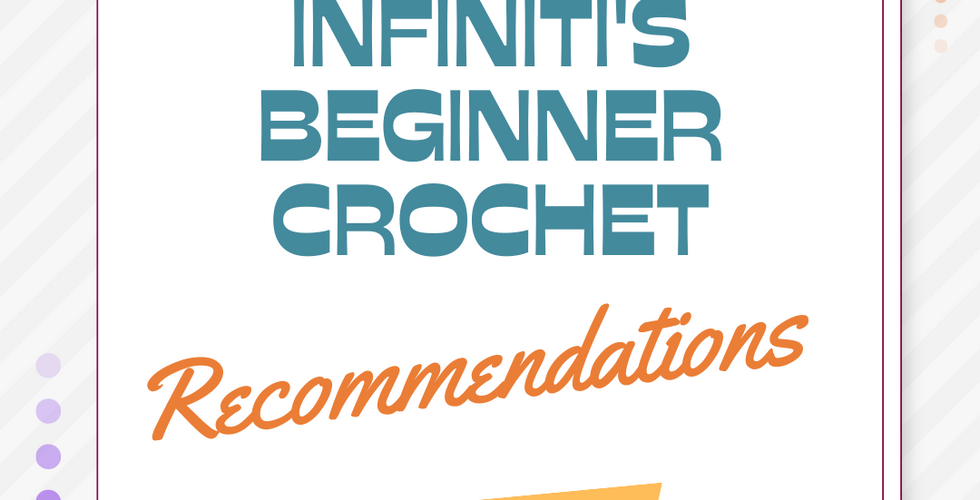What YOU need to start crocheting in 2024
- Infiniti

- Nov 30, 2023
- 6 min read
Updated: Jan 3, 2024
Hello Crafty! So you finally decided that THIS is the year you will start your crochet journey. CONGRATS! Ten years ago I also picked up a crochet hook and now it's my whole personality and how I make a living. I know...drastic, right?
But it's true! I took to teaching crochet online because it was such a therapeutic thing for me and at the time, I thought it would aid in my practice as an educator. Now, I have a combined audience of 35k between YouTube and Rumble who all trust me to know and convey the yarny things.
Today, I don't want to take up too much of your time but, I want to provide you with a little list of all the supplies you will need to get started in crochet. At the end of this post, I'll also leave you all with an ancient video where I talk about the specifics of my crochet knowledge. I hope that you enjoy this post and if you do, consider subscribing to one of my channels to continue your creative journey with me.

Let's Dive In!
Please Note: Infiniti Crafting Co. is a participant in multiple affiliate programs. If you purchase something from the affiliate links, I will get a small commission with no extra cost to you.
Crochet Hooks
There are all sorts of crochet hooks out there for you. Over the years I've collected nearly 200 of them so, needless to say, I've got a real feel for what's good. When I started out with crochet, I
was 15 and jobless so, my main prerogative while getting into a new hobby was economics.
Keeping that in mind, I want to warn you, do not buy those cheap 20pcs for $2, bamboo hooks. Most people don't know that they require sanding before use and even then, they have the tendency to snag your yarn.
You also want to consider your hands. If I were to start all over today, I'd recommend a 5.50mm ergonomic crochet hook for comfort. Though I also see nothing wrong with the standard set of aluminum hooks. Lord knows I have tons of them!

Yarn
There are all sorts of yarns out there for you but, when you're first learning crochet, you don't need
all the fancy stuff. When I started learning, I used value yarns like Red Heart Super Saver. There are other good options too, such as Caron Jumbo or Big Twist Value.
These are your basic, economy acrylic yarns and they make fabulous learner materials. I suppose the most important aspect here is that these synthetic fibers don't really lock or felt when you're working with them. This is so important when you're learning because you will inevitably rip stuff back.
Darning needles
These are made from aluminum or plastic and come straight or bent. A darning needle is a long, blunt needle with a large eye, specifically designed for weaving in ends of yarn. It is a very useful tool for crocheters, as it can help to make your projects look neat and tidy.
Here are some of the reasons why you need a darning needle for crochet:
To weave in ends. This is the most common use for a darning needle. When you crochet, you often have to leave long tails of yarn. These tails can be unsightly, so it is important to weave them in so that they are hidden. A darning needle makes this task much easier, as it can easily pass through the stitches of your crochet work.
To join pieces together. If you are making a project that is made up of multiple pieces, such as a blanket or a scarf, you will need to join the pieces together. A darning needle can be used to sew the pieces together neatly.
To repair holes. If you accidentally make a hole in your crochet work, you can use a darning needle to repair it. Simply weave the darning needle through the stitches around the hole, and then pull the yarn tight.
Stitch Markers
Stitch markers are small, portable objects that are used to mark specific stitches in crochet projects. They can be used for a variety of purposes, including:
Marking the beginning and end of rows or rounds. This helps to ensure that you don't accidentally skip or repeat stitches.
Marking increases and decreases. This helps you to keep track of where you need to add or subtract stitches.
Marking repeats in patterns. This can be helpful when working with complex patterns with multiple repeats.
Keeping track of stitch counts. This is especially helpful when working with large projects or projects with many different stitch types.
Stitch markers are not absolutely necessary for crochet, but they can be very helpful for ensuring accuracy and preventing errors. If you are a beginner crocheter, or if you are working on a complex project, I would recommend using stitch markers.
If you are looking for stitch markers, there are many different types available. You can find them in a variety of colors, shapes, and sizes. Some popular types of stitch markers include:
Plastic locking stitch markers. These markers have a small loop that you can hook your
yarn into. They are easy to use and they won't fall out of your work.
Safety pins. Safety pins can also be used as stitch markers. They are a bit more bulky than plastic locking stitch markers, but they can be helpful for marking large stitches.
Thread markers. Thread markers are small pieces of yarn that are threaded onto a needle. They are very lightweight and they can be easily hidden in your work.
Scissors
Scissors are an essential tool for crocheting, as they are used to cut yarn and trim ends.
Here are some of the reasons why you need scissors for crochet:
To cut yarn. When you are finished crocheting a project, you will need to cut the yarn. Scissors are the best tool for this task, as they will give you a clean and precise cut.
To trim ends. As you crochet, the ends of the yarn will fray. To prevent this, you can trim the ends with scissors. This will help to keep your project looking neat and tidy.
To make adjustments. If you make a mistake while crocheting, you may need to make an adjustment. Scissors can be used to cut out a stitch or to shorten a row.
To add details. Scissors can be used to add details to your crochet projects. For example, you can use scissors to cut fringe or to make tassels.
When choosing scissors for crochet, it is important to choose a pair that is sharp and comfortable to use. You should also choose a pair that is the right size for your needs. If you are crocheting with thick yarn, you will need a pair of scissors that is large enough to cut through the yarn easily.
If you're in a pinch or not too sure you want to invest a bunch of money into supplies, I recommend getting this crochet kit (scissors are not included). It includes lots of bon bon sized yarns, a variety of stitch markers, darning needles, a tape measure, crochet hooks and other addons that make this process less complicated.
It's the ideal gift for someone who's been wanting to test the waters with crochet, ( i.e, your kids, grandkids, your bff).
In addition to all the fun tools and supplies, I recommend checking out my crochet YouTube channel where I share my passion for the fiber arts by teaching you how to crochet (and knit)!
Tape Measure
A tape measure is a helpful tool for crocheting, especially when you are working on projects that require a specific size or gauge. Here are some of the reasons why you might need a tape measure for crochet:
To measure gauge. Gauge is the number of stitches and rows per inch in your crochet work. It is important to measure your gauge so that your project will turn out the correct size. A tape measure can help you to accurately measure your gauge.
To measure the size of a project. If you are crocheting a project that has specific dimensions, such as a hat or a scarf, you will need to measure the size of the project as you go. A tape measure can help you to accurately measure the size of your project.
To measure the length of yarn. If you are working on a project that requires a specific amount of yarn, you can use a tape measure to measure the length of yarn you have used. This will help you to determine how much more yarn you need to purchase.
To measure the circumference of a body part. If you are crocheting a garment, you may need to measure the circumference of a body part, such as the chest or the waist. A tape measure can help you to accurately measure the circumference of a body part.
While a tape measure is not an essential tool for crocheting, it can be a helpful tool for ensuring that your projects turn out the correct size. If you are serious about crocheting, I would recommend investing in a tape measure.
For a more one-on-one learning experience, consider signing up for my new Ultimate Crochet Course where I take you through a step-by-step learning experience. There are 22 topics that take you through the basics as well as some pro-tips sprinkled in along the way. Each demo is filmed in first person POV so you can clearly see how to do each technique.
By the end of the class, you'll have a strong understanding of the craft and will be well on your way to making your first successful crochet projects! At the end, you'll get a certificate of completion that you can fill out and print off.























Comments